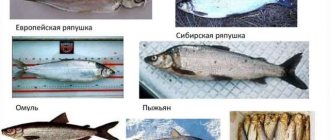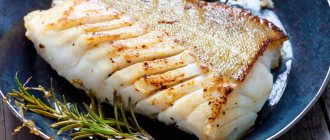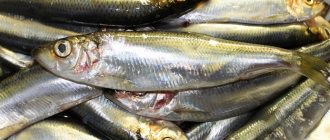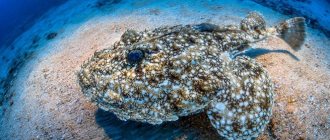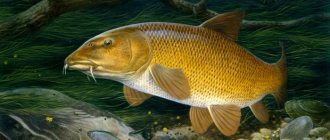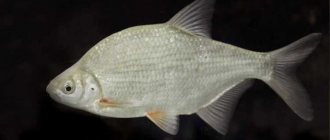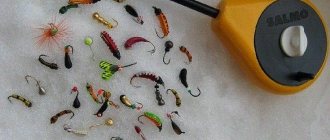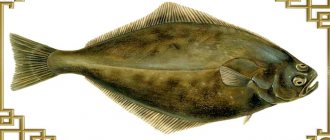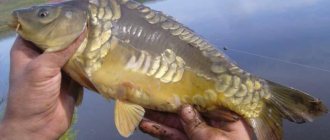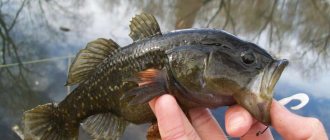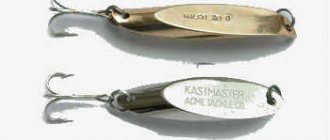Family characteristics
Codfish are ray-finned fish of the order Gadidae. Almost all of them live in salt water and only one species - burbot - prefers freshwater reservoirs. Representatives of this family can vary significantly in size and appearance, but they share some common features that make it possible to identify cod fish:
- the body is diamond-shaped, elongated in the tail area and widened slightly beyond the pectoral fins,
- a developed caudal fin, which can either grow together with the dorsal or anal fins or be clearly separated from them in different fish species,
- large, oblong head, with the upper jaw slightly longer than the lower jaw,
- the presence of one “whisker” - a fleshy long process in the chin area,
- depending on the subfamily, cod have a different number of fins: either 3 dorsal and 2 anal in cod-like ones, or 2 dorsal and 1 anal in burbot-like ones,
- the absence of spine-rays in all fins is the main difference between real representatives of the family and other fish similar to cod,
- large gill openings,
- very small, sharp scales, in which each scale fits tightly to each other,
- color features: the abdominal part is white, the sides are olive or brown-green, covered with a large number of small dark spots.
Cod fish grow in size throughout their lives: some very old individuals reach almost two meters in length, but they are very rare and the average fish about 10 years old reaches only 40-80 centimeters. These fish live up to 25 years. Among the cod there are both herbivores and plankton feeders, and predators: the latter are usually larger, for example, moth and Atlantic cod, but among the former there are also very small fish, such as the deep-sea viper, which does not grow more than 15 centimeters.
The benefits of cod
- It is rich in vitamins and microelements that normalize the functioning of all systems of the human body. Its use strengthens the immune system, reduces the development of seasonal vitamin deficiency, colds and infectious diseases.
- Thanks to the large amount of protein, it is useful for people exposed to heavy physical and mental stress, and athletes.
- This is an easily digestible product that improves the functioning of the digestive system. The phosphorus it contains helps cleanse the body of harmful substances.
- Iodine improves brain activity and blood supply to the brain, and also prevents senile dementia.
- Magnesium, sodium, potassium and healthy fatty acids improve the functioning of the heart and blood vessels. Blood cholesterol levels decrease and blood pressure stabilizes.
- Cod ensures high-quality functioning of the nervous system . It is useful for stress, apathy, increased irritability, neuroses, and insomnia.
- The appearance of the skin, nails and hair structure improves.
- Phosphorus and calcium make bones stronger, strengthen cartilage tissue, and help the body recover faster from fractures.
- Iron helps normalize the hematopoietic system, regulates blood clotting, and prevents the occurrence of anemia.
- Vitamin E and other antioxidants protect body cells from free radicals and reduce the risk of cancer.
Habitats
Cod and its relatives are distinguished by their extensive habitat, which includes almost all aquatic zones of the Earth, with the exception of the equatorial ones. Most species can be found in the northern seas, but some - five in total - also live in the waters of the Southern Hemisphere. A large number of common cod live in the Baltic Sea, many breeds live in the eastern part of the Atlantic, and some species have chosen the coastal areas of South America, South Africa and New Zealand.
All types of cod, except burbot, which prefers fresh water bodies of America and Eurasia, live in the seas, but some of them have adapted to water of moderate salinity and enter rivers to spawn. Basically, cod fish live in the bottom layers of water, but they prefer a shallow depth - about a hundred meters. Thus, their favorite places are coastal areas, shallow seas and continental shelf waters. In addition, they love cold (up to 10 °C), but well-lit water.
It is typical for fish of this family to somewhat change the places where they live during their lives. Cod sometimes migrate very long distances in search of better food and temperature conditions, as well as in response to changing currents.
Nutrition and diet
The diet of cod is quite diverse, among them there are both herbivores and predatory fish. Common cod is a carnivore, but at a young age it is a benthophage, that is, it feeds on a variety of mollusks and crustaceans from the bottom. Only after reaching 3-4 years of age and the end of the first spawning does it become a full-fledged predator, hunting other fish.
The main prey of cod is herring, navaga, saury, capelin, and pollock. She does not disdain fry of her own species. The diet of some breeds includes crabs, shrimp, octopuses and other representatives of marine fauna, depending on their habitat. Some small subspecies, for example, Arctic and Kilda cod, feed on small mollusks and crustaceans until the end of their lives. Lake species also eat worms and insect larvae.
Spawning and reproduction
Most cod fish reach sexual maturity by 3–5 years , but some of them, including ordinary cod, go to their first spawning only 8–10 years after birth. It occurs in late winter or early spring, when the air temperature is approximately 0 °C, and lasts for several days. The fertility of different members of the family differs significantly : they can lay from several thousand to several million eggs.
In connection with spawning, many cod species migrate to new habitats - northern species, for example, enter desalinated water, and some even into river mouths. The fry of these fish, having barely hatched, already begin to spread over long distances by sea and ocean currents. The young of some species, such as haddock, use the tentacles of jellyfish as protection from enemies.
Industrial fishing
Due to the fact that most cod species have unsurpassed nutritional qualities, they are caught on a huge industrial scale. Every year about 10 million tons of cod fish are caught and most of them are caught in the Atlantic Ocean.
As a rule, the bulk consists of the following types of cod:
- Atlantic cod.
- Pacific pollock.
- Haddock.
- Saida.
Almost all of them lead a bottom-dwelling lifestyle, so they are caught using deep-sea trawls. The meat of these fish is a popular product due to its nutritional value. Their liver is considered especially valuable, as it contains a huge amount of useful substances.
Types of cod
There are 56 species of cod fish in total. The classification distinguishes 4 subfamilies and 20 genera of these creatures. Many of them are actively used by humans in fishing - they are especially popular among buyers due to their tasty and healthy meat, almost devoid of bones. This is the list of the most famous species belonging to the cod family:
- cod,
- pollock,
- haddock,
- burbot,
- Molva, aka sea pike,
- little minute,
- navaga,
- Arctic cod,
- pollock,
- whiting,
- tomcode,
- gadikul.
Varieties of cod
The phrase “ordinary cod” usually means three types of fish that belong to the genus of cod: Atlantic, Pacific and its subspecies - Greenland. In addition, according to the newest classification, pollock has also been included in it. Arctic cod are classified into a separate group: East Siberian and ice cod. Each of these fish has a number of features and differences from the others.
Atlantic or northern cod is the largest species of cod , with an adult length ranging from 40 cm to 2 m. It is found in temperate latitudes of the Atlantic Ocean. This species is highly valued not only for its meat, but also for its liver, rich in fats and vitamins. In 1992, due to the decline in the population of the species, a ban on catching Atlantic cod was introduced in Canada, and now it is listed in both the International Red Book and the Russian Red Book. In addition, this species includes several subspecies, including:
- Atlantic cod is the main subspecies. It is distinguished by its large size, as well as its green, olive or brown body color with small gray-brown spots and a white or yellowish belly.
- Kildin cod is a subspecies that lives only in one Lake Mogilnoye, which is located on the island of Kildin. This lake is distinguished by its unique composition and structure of water layers, due to which it is classified as a hydrological natural monument. Kildin cod can be distinguished from others by its small size, which it acquired during evolution due to the nature of its food - the fish grow up to only 50 cm and weigh no more than 2.5 kg. In addition, they are distinguished by a small mouth opening with shortened jaws and a brighter color than that of Atlantic cod. The species has been pushed to the brink of extinction by pollution of its habitat and uncontrolled trapping, and now accounts for only a few dozen individuals protected by the government.
- Baltic cod is a breed whose main populations live in the Baltic Sea. It is also found in the Gulf of Finland and the Gulf of Bothnia, but in smaller quantities. The length of an adult fish is from 80 cm to 1 m, weight is within 12 kg.
- White Sea cod is a fish that lives mostly in the White Sea, more precisely, in its Kandalaksha and some other bays. They are distinguished by their small size compared to most of their relatives, about 60 cm in length and a darker color than other subspecies. Some scientists classify this subspecies as Greenland cod.
- Pacific or Far Eastern cod is the second independent species, which differs from Atlantic cod in its large head and smaller size, as well as in the underdeveloped outgrowth at the base of the swim bladder. The size of the fish grows from 45 cm to 1.2 m, no more than 23 kg. This can be found in the northern water zone of the Pacific Ocean and in some seas, such as the Japanese Sea. It is also distinguished from other cod by laying not floating, but sticking eggs.
- Greenland cod, which received its name from the island of Greenland, the coastal waters of which constitute its main habitat, has become the subject of controversy among scientists: some distinguish it as an independent species, others argue that it is only a subspecies of its Far Eastern relative. It differs from it mainly in its smaller body size: about 70-80 cm. The diet of the species consists mainly of invertebrates and is sometimes diluted with small fish.
- Ice cod, separated together with its closest relative into a separate genus, lives in the Arctic Ocean, the coastal zone of Greenland and off Wrangel Island; individual small schools are also found north of the Bering Strait. It is distinguished by a very small, about 30 cm long, large head with large, noticeable eyes and a very short, or even absent, antennae. The body color of the fish is inconspicuous and gray. The basis of its diet is plankton.
- East Siberian cod is another small species with a body length of 50-55 cm and a weight of no more than 1.5 kg. Its range includes the coastal waters of Siberia and the New Siberian Islands, as well as Greenland and North America, although sometimes some individuals swim as far as the Bering Strait. It feeds on crustaceans; especially large representatives sometimes attack pollock fry.
Some interesting facts about cod
- There is an opinion that cod is already 120 million years old and was originally a warm-water fish and only after some time migrated north and became a fish of cold waters
- According to one legend, cod received its name among the people for an unusual property: when the fish is dried, its meat cracks, hence the name cod. Another version of the name is that large schools of fish that go to spawn make cracking sounds, they arise due to contraction of the muscles of the swim bladder
- Another good thing about cod is that all its parts are used. For example, cod liver is not only a delicacy, but also a valuable raw material for the pharmaceutical industry. Medical fish oil is extracted from it and then used for cosmetic purposes.

